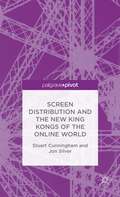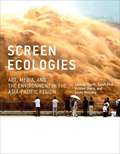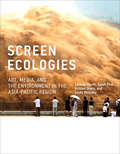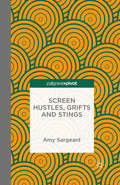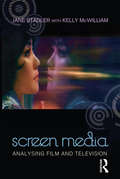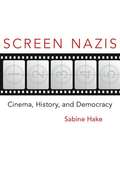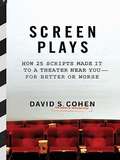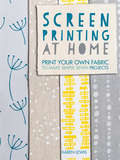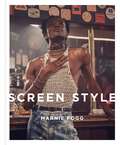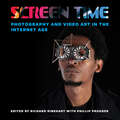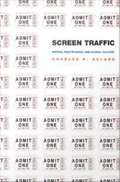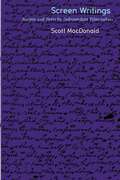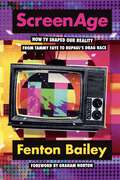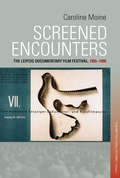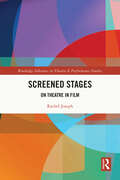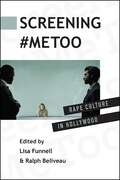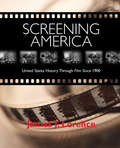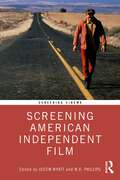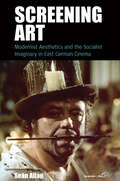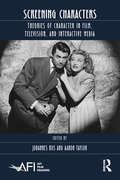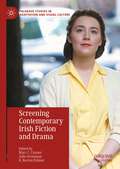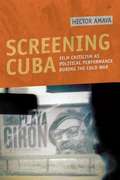- Table View
- List View
Screen Distribution and the New King Kongs of the Online World
by Stuart Cunningham Jon SilverDrawing on comparisons with historical shake-ups in the film industry, Screen Distribution Post-Hollywood offers a timely account of the changes brought about in global online distribution of film and television by major new players such as Google/YouTube, Apple, Amazon, Yahoo , Facebook, Netflix and Hulu.
Screen Ecologies: Art, Media, and the Environment in the Asia-Pacific Region
by Linda Williams Sarah Pink Larissa Hjorth Kristen SharpImages of environmental disaster and degradation have become part of our everyday media diet. This visual culture focusing on environmental deterioration represents a wider recognition of the political, economic, and cultural forces that are responsible for our ongoing environmental crisis. And yet efforts to raise awareness about environmental issues through digital and visual media are riddled with irony, because the resource extraction, manufacturing, transportation, and waste associated with digital devices contribute to environmental damage and climate change. Screen Ecologies examines the relationship of media, art, and climate change in the Asia-Pacific region -- a key site of both environmental degradation and the production and consumption of climate-aware screen art and media.Screen Ecologies shows how new media and visual artists provide alternative ways for understanding the entanglements of media and the environment in the Asia-Pacific. It investigates such topics as artists' exploration of alternative ways to represent the environment; regional stories of media innovation and climate change; the tensions between amateur and professional art; the emergence of biennials, triennials, and new arts organizations; the theme of water in regional art; new models for networked collaboration; and social media's move from private to public realms. A generous selection of illustrations shows a range of artist's projects.
Screen Ecologies: Art, Media, and the Environment in the Asia-Pacific Region (Leonardo)
by Linda Williams Sarah Pink Larissa Hjorth Kristen SharpHow new media and visual artists provide alternative ways for understanding and visualizing the entanglements of media and the environment in the Asia-Pacific.Images of environmental disaster and degradation have become part of our everyday media diet. This visual culture focusing on environmental deterioration represents a wider recognition of the political, economic, and cultural forces that are responsible for our ongoing environmental crisis. And yet efforts to raise awareness about environmental issues through digital and visual media are riddled with irony, because the resource extraction, manufacturing, transportation, and waste associated with digital devices contribute to environmental damage and climate change. Screen Ecologies examines the relationship of media, art, and climate change in the Asia-Pacific region—a key site of both environmental degradation and the production and consumption of climate-aware screen art and media.Screen Ecologies shows how new media and visual artists provide alternative ways for understanding the entanglements of media and the environment in the Asia-Pacific. It investigates such topics as artists' exploration of alternative ways to represent the environment; regional stories of media innovation and climate change; the tensions between amateur and professional art; the emergence of biennials, triennials, and new arts organizations; the theme of water in regional art; new models for networked collaboration; and social media's move from private to public realms. A generous selection of illustrations shows a range of artist's projects.
Screen Hustles, Grifts and Stings: Stings, Grifts, Hustles and the Long Con
by A. SargeantScreen Hustles, Grifts and Stings identifies recurrent themes and techniques of the con film, suggests precedents in literature and discusses the perennial appeal of the con man for readers and viewers alike. Core studies span from film (Catch Me If You Can, Paper Moon, House of Games) to television (Hustle), from Noir (The Grifters) to Romantic Comedy (Gambit). Frequently, the execution of the con is only finely distinguishable from the conduct of a legitimate profession and, challengingly, a mark is often shown to be culpable in his or her undoing. The best con films, it is suggested, invite re-watching and reward the viewer accordingly: who is complicit and when? How and where is the con achieved? When is the viewer party to the con? And what, if any, moral is to be drawn?
Screen Media: Analysing Film and Television
by Jane Stadler Kelly McWilliamScreen Media offers screen enthusiasts the analytical and theoretical vocabulary required to articulate responses to film and television. The authors emphasise the importance of 'thinking on both sides of the screen'. They show how to develop the skills to understand and analyse how and why a screen text was shot, scored, and edited in a particular way, and then to consider what impact those production choices might have on the audience.Stadler and McWilliam set production techniques and approaches to screen analysis in historical context. They demystify technological developments and explain the implications of increasing convergence of film and television technologies. They also discuss aesthetics, narrative, realism, genre, celebrity, cult media and global screen culture. Throughout they highlight the links between screen theory and creative practice.With extensive international examples, Screen Media is an ideal introduction to critical engagement with film and television.'Screen Media offers a systematic approach to film and television analysis. The examples chosen by the authors are both appropriate and timely, and are presented in a very lively and readable form that will appeal to an international readership.' - Rebecca L. Abbott, Professor of Film, Video + Interactive Media, Quinnipiac University, USA
Screen Nazis
by Sabine HakeFrom the late 1930s to the early twenty-first century, European and American filmmakers have displayed an enduring fascination with Nazi leaders, rituals, and symbols, making scores of films from Confessions of a Nazi Spy (1939) and Watch on the Rhine (1943) through Des Teufels Gentral (The Devil's General, 1955) and Pasqualino settebellezze (Seven Beauties, 1975) up to Der Untergang (Downfall, 2004), Inglourious Basterds (2009), and beyond.
Screen Plays: How 25 Scripts Made It to a Theater Near You--for Better or Worse
by David S. CohenIn this fascinating survey of contemporary screen craft, David Cohen of Script and Variety magazines leads readers down the long and harrowing road every screenplay takes from idea to script to screen. In interviews with Hollywood screenwriters from across the board-Oscar winners and novices alike-Cohen explores what sets apart the blockbuster successes from the downright disasters. Tracing the fortunes of twenty-five films, including Troy, Erin Brockovich, Lost in Translation, and The Aviator, Cohen offers insider access to back lots and boardrooms, to studio heads, directors, and to the over-caffeinated screenwriters themselves. As the story of each film evolves from the drawing board to the big screen, Cohen proves that how a script is written, sold, developed, and filmed can be just as dramatic and intriguing as the movie itself-especially when the resulting movie is a fiasco. Covering films of all kinds-from tongue-in-cheek romps like John Waters's A Dirty Shame to Oscar winners like Monster's Ball and The Hours-Screen Plays is an anecdote-filled, often inspiring, always revealing look at the alchemy of the movie business. With Cohen as your expert guide, Screen Plays exposes how and why certain films (such as Gladiator) become "tent poles," those runaway successes every studio needs to survive, and others become train wrecks. Full of critical clues on how to sell a script-and avoid seeing it destroyed before the director calls Action!-it's the one book every aspiring screenwriter will find irresistible.
Screen Printing at Home: Print Your Own Fabric to Make Simple Sewn Projects
by Karen LewisCreate hand-printed fabrics—and use them to make aprons, tote bags, and more! Do you love the idea of printing your own fabrics at home but don&’t know where to start? This comprehensive guide to screen printing shows you just how easy it is to create beautiful, hand-printed fabrics at your kitchen table. Screen printing expert Karen Lewis demonstrates two screen printing techniques—stenciling and screen filler—and how they can be used to create stunning, professional results with basic, inexpensive equipment. Both techniques are explained using step-by-step text and photography. Karen also explains how to create simple, sewn projects from your hand-printed fabrics. The sewing patterns include an apron, tote bag, and tea cozy, as well as ideas for how to print on ready-made items like tea towels to make delightful gifts for friends and family.
Screen Style
by Marnie FoggScreen Style celebrates the beautiful, stylish and often covetable outfits and costumes featured in 50 iconic and diverse series of the small screen: from Mad Men to Call My Agent, Bridgerton to Empire.By organising the series into genres - Comedy, Coming of Age, Crime, Historical, Retro, Contemporary - the author shows how designers take different approaches when manipulating the latent power of dress to create convincing characters and enhance the experience of the viewer. She reveals how the characters themselves can become role models for what to wear, transforming actors into fashion influencers.The book is beautifully illustrated with over 250 screen stills, each accompanied by an extended caption, further demonstrating how TV series have helped to set the standard for fashion on and off screen.
Screen Style
by Marnie FoggScreen Style celebrates the beautiful, stylish and often covetable outfits and costumes featured in 50 iconic and diverse series of the small screen: from Mad Men to Call My Agent, Bridgerton to Empire.By organising the series into genres - Comedy, Coming of Age, Crime, Historical, Retro, Contemporary - the author shows how designers take different approaches when manipulating the latent power of dress to create convincing characters and enhance the experience of the viewer. She reveals how the characters themselves can become role models for what to wear, transforming actors into fashion influencers.The book is beautifully illustrated with over 250 screen stills, each accompanied by an extended caption, further demonstrating how TV series have helped to set the standard for fashion on and off screen.
Screen Time: Photography and Video Art in the Internet Age
by Richard Rinehart and Phillip ProdgerPublished on the occasion of the art exhibition Screen Time: Photography and Video Art in the Internet Age, this catalog features a selection of leading international artists who engage with and critique the role of media in contemporary society. Their work demonstrates what has become known as post-internet artistic practices—art that may or may not be made for the internet but nevertheless acknowledges online culture as an omnipresent influence, inseparable from contemporary social conditions. They ask what it means to be a photographer when everyone is an Instagram influencer; what it means to make video art when everyone is a TikTok video star; and how to deliver meaningful social commentary in the age of the meme. The exhibition and accompanying catalog showcase artwork by N. Dash, Nathalie Djurberg, Marcel Dzama, Peter Funch, Cyrus Kabiru, William Kentridge, Christian Marclay, Marilyn Minter, Vik Muniz, Otobong Nkanga, Erwin Olaf, Robin Rhode, Vee Speers, Mary Sue, Puck Verkade, Huang Yan. Published by Bucknell University Press for the Samek Art Museum. Distributed worldwide by Rutgers University Press.
Screen Traffic: Movies, Multiplexes, and Global Culture
by Charles R. AclandIn Screen Traffic, Charles R. Acland examines how, since the mid-1980s, the U. S. commercial movie business has altered conceptions of moviegoing both within the industry and among audiences. He shows how studios, in their increasing reliance on revenues from international audiences and from the ancillary markets of television, videotape, DVD, and pay-per-view, have cultivated an understanding of their commodities as mutating global products. Consequently, the cultural practice of moviegoing has changed significantly, as has the place of the cinema in relation to other sites of leisure. Integrating film and cultural theory with close analysis of promotional materials, entertainment news, trade publications, and economic reports, Acland presents an array of evidence for the new understanding of movies and moviegoing that has developed within popular culture and the entertainment industry. In particular, he dissects a key development: the rise of the megaplex, characterized by large auditoriums, plentiful screens, and consumer activities other than film viewing. He traces its genesis from the re-entry of studios into the movie exhibition business in 1986 through 1998, when reports of the economic destabilization of exhibition began to surface, just as the rise of so-called e-cinema signaled another wave of change. Documenting the current tendency toward an accelerated cinema culture, one that appears to arrive simultaneously for everyone, everywhere, Screen Traffic unearths and critiques the corporate and cultural forces contributing to the "felt internationalism" of our global era.
Screen Writings: Texts and Scripts from Independent Films
by Scott MacDonald"Ask audience to cut the part of the image on the screen that they don't like. Supply scissors."—Yoko Ono, Tokyo, June 1964A dazzling range of unconventional film scripts and texts, many published for the first time, make up Scott MacDonald's newest collection. Illustrated with nearly 100 film stills, this fascinating book is at once a reference work of film history and an unparalleled sampling of experimental "language art." It contributes to the very dissipation of boundaries between cinematic, literary, and artistic expression thematized in the films themselves. Each text and script is introduced and contextualized by MacDonald; a filmography and a bibliography round out the volume.This is a readable—often quite funny—literature that investigates differences between seeing and reading. Represented are avant-garde classics such as Hollis Frampton's Poetic Justice and Zorns Lemma and Morgan Fisher's Standard Gauge, and William Greaves's recently rediscovered Symbiopsychotaxiplasm: Take One. Michael Snow turns film loose on language in So Is This; Peter Rose turns language loose on theory in Pressures of the Text.Some of the most influential feminist filmscripts of recent decades—Laura Mulvey and Peter Wollen's Riddles of the Sphinx, Su Friedrich's Gently Down the Stream, Trinh T. Minh-ha's Reassemblage, Yvonne Rainer's Privilege—confirm this book's importance for readers in gender and cultural studies as well as for filmmakers and admirers of experimental writing, independent cinema, and the visual arts in general.
Screen-Free Crafts Kids Will Love: Fun Activities that Inspire Creativity, Problem-Solving and Lifelong Learning
by Lynn Lilly The Craft Box Girls TeamA COLLECTION OF EDUCATIONAL, ENTERTAINING CRAFTS THAT ARE SURE TO GET KIDS AND PARENTS TO UNPLUG AND INTERACTDoes your child spend too much time in front of a screen? Help them discover the excitement of hands-on learning with Screen-Free Crafts Kids Will Love. Packed with DIY projects like a personalized race track chore tracker, a high-flying homemade 3D kite and handmade musical instruments, the activities in this book will encourage your child to explore the world beyond the screen.Screen-Free Crafts Kids Will Love features step-by-step instructions and color photosfor over 60 entertaining and educational projects that are guaranteed to:• Promote lifelong learning• Stimulate creativity• Improve problem solving• Spur imaginative thinking• Encourage independent playtimeAnd the fun doesn&’t end when the crafting is over. Youngsters will love making and playing with their new handmade creations on game night, at parties, during holidays and more.
ScreenAge: How TV shaped our reality, from Tammy Faye to RuPaul’s Drag Race
by Fenton Bailey'Like a superheated kernel of corn, the world has gone Pop... Drag has become mainstream. Being gay became cool. From being the criminal outsider, being queer has even become representative of the way the outsider voice is common to us all.'When he moved to New York in 1982, Fenton Bailey saw the world go Pop. Together with filmmaking partner Randy Barbato, their production company World of Wonder would pioneer the genre of Reality TV and chronicle the emerging Screen Age through their extraordinary programs and outrageous subjects - from Bible Belt televangelists and conspiracy theories to pioneering drag queens.Working with icons such as Britney Spears, Tammy Faye Bakker and RuPaul, the production company's shows tell a wider story of how television has fundamentally shifted our reality.Packed with glorious insider gossip and amazing celebrity stories, these are the riotous tales behind the shows that would make ScreenAgers of us all.
Screened Encounters: The Leipzig Documentary Film Festival, 1955-1990 (Film and the Global Cold War #1)
by Caroline MoineEstablished in 1955, the Leipzig International Documentary Film Festival became a central arena for staging the cultural politics of the German Democratic Republic, both domestically and in relation to West Germany and the rest of the world.�Screened Encounters�represents the definitive history of this key event, recounting the political and artistic exchanges it enabled from its founding until German unification, and tracing the outsize influence it exerted on international cultural relations during the Cold War.
Screened Encounters: The Leipzig Documentary Film Festival, 1955-1990 (Visual and Media Cultures of the Cold War and Beyond)
by Caroline MoineEstablished in 1955, the Leipzig International Documentary Film Festival became a central arena for staging the cultural politics of the German Democratic Republic, both domestically and in relation to West Germany and the rest of the world. Screened Encounters represents the definitive history of this key event, recounting the political and artistic exchanges it enabled from its founding until German unification, and tracing the outsize influence it exerted on international cultural relations during the Cold War.
Screened Stages: On Theatre in Film (ISSN)
by Rachel JosephThis book is devoted to tracing the variety of ways that theatre, theatricality, and performance are embedded in Hollywood cinema as screened stages.A screened stage is the literal or metaphorical appearance of a stage on screen. When the Hollywood style emerged in cinema history it traumatically severed the entwined relationship between film and theatre. The book makes the argument that cinema longs for theatre after that separation. The histories of stage and screen persistently crisscross one another making their separation problematic. The screened stage from the end of the nineteenth century until now offers a miniaturized version of cinema and theatre history. Moments of the stage within the screen compress historical styles and movements into saturated representations on film. Such examples overflow the cinematic screen into singular manifestations of presentness. Screened stages uncover what it means to be simultaneously present and absent.This book would be of great interest to students and scholars of theatre, film, dance, and performance.
Screening #MeToo: Rape Culture in Hollywood
by Lisa Funnell Ralph BeliveauScreening #MeToo offers an important and timely discussion of the pervasive nature of rape culture in Hollywood. Essays in the collection examine films released from the 1960s onward, a broad period that coincides with the end of the Motion Picture Production Code in Hollywood, which resulted in more frequent and increasingly graphic images of sex and violence being included in mainstream movies. Focusing on narratives in which surveillance and sexual violence feature prominently, contributors from North America and Europe examine a variety of film genres, including spy films, teen comedies, kitchen sink dramas, coming-of-age stories, rape/revenge films, and horror films. Reflecting the increasing social and academic awareness of sexual violence in Hollywood film and its transmission and cultivation of rape culture in the United States and abroad, they are concerned not only with the content of the films under scrutiny but also with the clear relationship between the stories, how they are being told, and the culture that produced them. Screening #MeToo challenges readers to look at mainstream Hollywood films differently, in light of attitudes about art and power, sexuality and consent, and the pleasures and frustrations of criticizing "entertainment" films from these perspectives.
Screening America: United States History through Film since 1900
by James J LorenceBy combining the study of films with the text-based primary sources, Screening America gives students clear guidance in studying, interpreting, and understanding the motion picture's significance as a primary source in investigating U.S. History.Students will come to understand history as not only the record of what governments did, but also the way in which people lived their lives, experienced the wider world, and engaged in leisure pursuits, from which we can learn much about the society in which they lived.
Screening American Independent Film (Screening Cinema)
by Justin Wyatt W. D. PhillipsThis indispensable collection offers 51 chapters, each focused on a distinct American independent film. Screening American Independent Film presents these films chronologically, addressing works from across more than a century (1915−2020), emphasizing the breadth and long duration of American independent cinema. The collection includes canonical examples as well as films that push against and expand the definitions of "independence." The titles run from micro-budget films through marketing-friendly Indiewood projects, from auteur-driven films and festival darlings to B-movies, genre pics, and exploitation films. The chapters also introduce students to different approaches within film studies including historical and contextual framing, industrial and institutional analysis, politics and ideology, genre and authorship, representation, film analysis, exhibition and reception, and technology. Written by leading international scholars and emerging talents in film studies, this volume is the first of its kind. Paying particular attention to issues of diversity and inclusion for both the participating scholars and the content and themes within the selected films, Screening American Independent Film is an essential resource for anyone teaching or studying American cinema.
Screening Art: Modernist Aesthetics and the Socialist Imaginary in East German Cinema (Film Europa #20)
by Seán AllanWith internationalist aspirations and wide-ranging historical perspectives, East German films about artists and their work became hotly contested spaces in which filmmakers could look beyond the GDR and debate the impact of contemporary cultural policy on the reception of their pre-war cultural heritage. Spanning newsreels, documentaries, and feature films, Screening Art is the first full-length investigation into a genre that has been largely overlooked in studies of DEFA, the state-owned Eastern German film studio. As it shows, “artist-films” played an essential role in the development of new paradigms of socialist art in postwar Europe.
Screening Characters: Theories of Character in Film, Television, and Interactive Media (AFI Film Readers)
by Johannes Riis Aaron TaylorCharacters are central to our experiences of screened fictions and invite a host of questions. The contributors to Screening Characters draw on archival material, interviews, philosophical inquiry, and conceptual analysis in order to give new, thought-provoking answers to these queries. Providing multifaceted accounts of the nature of screen characters, contributions are organized around a series of important subjects, including issues of class, race, ethics, and generic types as they are encountered in moving image media. These topics, in turn, are personified by such memorable figures as Cary Grant, Jon Hamm, Audrey Hepburn, and Seul-gi Kim, in addition to avatars, online personalities, animated characters, and the ensembles of shows such as The Sopranos, Mad Men, and Breaking Bad.
Screening Contemporary Irish Fiction and Drama (Palgrave Studies in Adaptation and Visual Culture)
by R. Barton Palmer Marc C. Conner Julie GrossmanIn this book, each chapter explores significant Irish texts in their literary, cultural, and historical contexts. With an introduction that establishes the multiple critical contexts for Irish cinema, literature, and their adaptive textual worlds, the volume addresses some of the most popular and important late 20th-Century and 21st Century works that have had an impact on the Irish and global cinema and literary landscape. A remarkable series of acclaimed and profitable domestic productions during the past three decades has accompanied, while chronicling, Ireland’s struggle with self-identity, national consciousness, and cultural expression, such that the story of contemporary Irish cinema is in many ways the story of the young nation’s growth pains and travails. Whereas Irish literature had long stood as the nation’s foremost artistic achievement, it is not too much to say that film now rivals literature as Ireland’s key form of cultural expression. The proliferation of successful screen versionings of Irish fiction and drama shows how intimately the contemporary Irish cinema is tied to the project of both understanding and complicating (even denying) a national identity that has undergone radical change during the past three decades. This present volume is the first to present a collective accounting of that productive synergy, which has seen so much of contemporary Irish literature transferred to the screen.
Screening Cuba: Film Criticism as Political Performance during the Cold War
by Hector AmayaHector Amaya advances into new territory in Latin American and U.S. cinema studies in this innovative analysis of the differing critical receptions of Cuban film in Cuba and the United States during the Cold War. Synthesizing film reviews, magazine articles, and other primary documents, Screening Cuba compares Cuban and U.S. reactions to four Cuban films: Memories of Underdevelopment, Lucia, One Way or Another, and Portrait of Teresa. In examining cultural production through the lens of the Cold War, Amaya reveals how contrasting interpretations of Cuban and U.S. critics are the result of the political cultures in which they operated. While Cuban critics viewed the films as powerful symbols of the social promises of the Cuban revolution, liberal and leftist American critics found meaning in the films as representations of anti-establishment progressive values and Cold War discourses. By contrasting the hermeneutics of Cuban and U.S. culture, criticism, and citizenship, Amaya argues that critical receptions of political films constitute a kind of civic public behavior.
